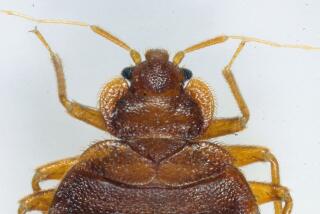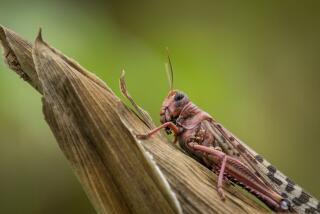Africa Locust Plague May Become Worst Recorded in Modern Times
- Share via
ROME — A plague of locusts that could become the biggest that modern man has known is sweeping voraciously across North and West Africa, foiling international counterattack, officials at the Rome headquarters of the U.N. Food and Agriculture Organization said last week.
“We are in big trouble,” said Lukas Brader, a Dutch entomologist who heads the FAO anti-locust campaign. “The speed of the locusts’ spread has caught us off balance. It could become the biggest locust plague ever if we are unable to stop it.” Reliable records on locust outbreaks go back about 100 years.
Already, 25,000 square miles--about the size of West Virginia--have been invaded by the winged desert locusts, who consume their weight in vegetation each day--200 tons per square mile. A 40-square-mile swarm of the migratory grasshoppers is considered moderate size, but swarms 10 times that size have been reported in previous infestations. By Brader’s reckoning, a sun-blackening 60-square-mile swarm of locusts weighs 10,000 tons, a biological mass equivalent to the weight of a good-sized ocean freighter.
The locusts, creatures of the wind, fly by day--as much as 100 miles. At night they eat anything that grows, leaving barren land behind them.
Crop Losses Minor
Thus far, crop losses have been slight, because the areas of worst infestation are lightly cultivated.
At potential risk from the outbreak, whose spread is surpassing a 1954 invasion that took more than a decade to eradicate, is all of Africa north of the Equator and the entire Middle East as far east as India and Pakistan, Brader said. About 1 billion people--a fifth of the world’s population--live in the endangered area, he said.
“This is almost a superhuman task,” FAO Director General Edouard Saouma said. “Swift and decisive action is needed to avoid a major regional food crisis later this year.”
The locust swarms, in which there are about 100 million insects per square mile, began their rampage this year in North Africa after unusually plentiful rainfall in remote inland desert areas in Mauritania and the Western Sahara. In recent days they have swung west with a vengeance.
Their future course depends on the winds, Brader said.
Greater Swarms Expected
Historically, the swarms move west and then east and south as the year progresses. What is particularly alarming this year is that the westward advance has come much earlier in the year than in the 1950s outbreak, suggesting greater swarms.
The Mediterranean island of Malta, Italy and other southern European countries are on the alert. The Italian government has created a precautionary interministerial task force to assess the threat. Aided by military radar, meteorologists think they will get a three- or four-day advance warning if a swarm attempts to cross the Mediterranean Sea.
There is no precedent for a locust invasion of the European mainland, according to Brader, but the Italian island province of Sardinia has been hit before, and over Easter a 60-mile stretch of beaches south of Rome was littered with dead locusts.
Communiques issuing from the emergency operations center at FAO headquarters to 158 member countries read like battle reports from a losing army.
Brader’s locust bulletin reaching FAO members Friday reads: “Major air and ground control campaigns continuing in Morocco and Algeria. . . . Tunisia quiet pending hatching. Numerous reports (of) swarms (in) central and southern Mauritania, Senegal, Gambia and western Mali indicate that this southerly migration (is) of much larger scale than anticipated. . . . Mature swarm seen (in) northwest Saudi Arabia and southeast Egypt indicates escapes on considerable scale from earlier breeding (in) Sudan-Egypt area. Situation in West Africa has deteriorated rapidly. This constitutes grave threat of further development of plague, and situation should be considered as an emergency.”
An FAO call for help on behalf of poor countries that are often barely self-sufficient in food production has won what Brader calls a heartening response of about $40 million in pledges from nearly two dozen international donors, including the United States, Canada, West European countries, Japan, the Soviet Union, China, the Organization of Petroleum Exporting Countries, the Islamic Development Bank and the European Economic Community.
Canada Sends Planes
Italian helicopters in Tunisia and Soviet planes in Algeria carry airborne pesticides to the locust swarms. Canada has sent planes, Japan and China pesticides, and the United States has sent both as part of a $12-million donation.
In a number of countries, including Morocco, the army has been called out to fight locusts. More than 7 million acres have been sprayed thus far in northwest Africa, with as much still to be done. This week Senegal asked for international help to spray another 5 million acres, and neighboring countries are also appealing for assistance against the threatening hordes. Unless a drought intervenes to help, Brader thinks the anti-locust campaign may ultimately cost $150 million.
“Our technology is better than ever, but the experts tell me we don’t have the proper pesticides anymore,” Brader said. Environmental concerns rule out DDT-family locust killers that were used effectively in previous infestations. The currently used pesticides of the organo-phosphate family and the carbamates group are safer but have only three- to five-day killing power.
Locust eggs take three weeks to hatch, though, so breeding areas have to be sprayed more than once.
More to Read
Sign up for Essential California
The most important California stories and recommendations in your inbox every morning.
You may occasionally receive promotional content from the Los Angeles Times.













